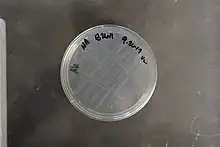| Comamonas testosteroni | |
|---|---|
 | |
| Scientific classification | |
| Domain: | Bacteria |
| Phylum: | Pseudomonadota |
| Class: | Betaproteobacteria |
| Order: | Burkholderiales |
| Family: | Comamonadaceae |
| Genus: | Comamonas |
| Species: | C. testosteroni |
| Binomial name | |
| Comamonas testosteroni (Marcus and Talalay 1956) Tamaoka et al. 1987 | |
| Synonyms | |
| |
Comamonas testosteroni is a Gram-negative environmental bacterium capable of utilizing testosterone as a carbon source, and degrading other sterols such as ergosterol and estrogens.[1] Strain I2gfp has been used in bioaugmentation trials, in attempts to treat the industrial byproduct 3-chloroaniline.[2] It was first classified as a human pathogen in 1987 according to the National Library of Medicine. After years of testing, it has been revealed that it can digest certain types of plastic.[3]
Benefits
Plastic is not organic and can take years to decompose. It is bad for our environment as it increases global warming and pollution. Scholars have gone as far as to call it “nature’s plastic recycling center".[4] There is also optimism that scientists can study how comamonas testosteroni digests plastic and replicate it artificially and more efficiently
Virulence
Though these organisms have low virulence, they can occasionally cause human diseases. They can be found in intravenous catheters, the respiratory tract, abdomen, urinary tract, and the central nervous system. Symptoms of infection may variously include vomiting, watery diarrhea, and meningitis.[5]
References
- ↑ Liu, Na; Shi, Yue-e; Li, Jialu; Zhu, Meiling; Zhang, Tingdi (September 2021). "Identification and genome analysis of Comamonas testosteroni strain JLU460ET, a novel steroid-degrading bacterium". 3 Biotech. 11 (9): 404. doi:10.1007/s13205-021-02949-8. PMC 8353041. PMID 34458066.
- ↑ Boon, Nico; Goris, Johan; De Vos, Paul; Verstraete, Willy; Top, Eva M. (July 2000). "Bioaugmentation of Activated Sludge by an Indigenous 3-Chloroaniline-Degrading Comamonas testosteroni Strain, I2 gfp". Applied and Environmental Microbiology. 66 (7): 2906–2913. Bibcode:2000ApEnM..66.2906B. doi:10.1128/AEM.66.7.2906-2913.2000. PMC 92090. PMID 10877785.
- ↑ Wilkes, Rebecca A.; Waldbauer, Jacob; Caroll, Austin; Nieto-Domínguez, Manuel; Parker, Darren J.; Zhang, Lichun; Guss, Adam M.; Aristilde, Ludmilla (May 2023). "Complex regulation in a Comamonas platform for diverse aromatic carbon metabolism". Nature Chemical Biology. 19 (5): 651–662. doi:10.1038/s41589-022-01237-7. PMC 10154247. PMID 36747056.
- ↑ Morris, Amanda (6 February 2023). "How waste-eating bacteria digest complex carbons". Northwestern Now.
- ↑ Farooq, Shaika; Farooq, Rumana; Nahvi, Nahida (31 January 2017). "Comamonas testosteroni: Is It Still a Rare Human Pathogen". Case Reports in Gastroenterology. 11 (1): 42–47. doi:10.1159/000452197. PMC 5301100. PMID 28203137.
External links
- Ettinger, Jill (29 October 2023). "Scientists discovered a common bacterium that can 'eat' plastic whole — and the breakthrough could be game-changing". The Cool Down.
- "Comamonas testosteroni | Type strain | DSM 50244, ATCC 11996, ICPB 2741-78, NCIB 8955, CCUG 1426, NRRL B-2611, NCTC 10698, LMG 1786, JCM 5832, BCRC 11023, BCRC 14822, CCM 1931, CECT 326, CIP 59.24, HAMBI 403, IAM 12419, IFO 14951, JCM 6221, KCTC 1772, LMG 1800, NBRC 14951, NCAIM B.01655, NCAIM B.01926, NCIMB 8955, NCPPB 1969, VKM B-1241, VTT E-86249 | BacDiveID:2923".